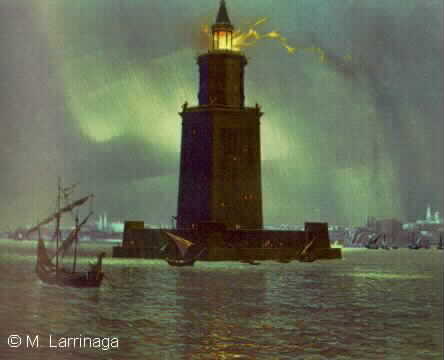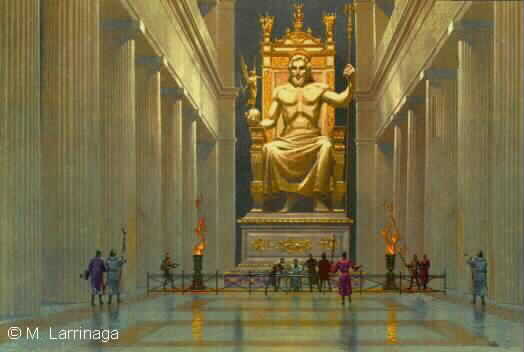|
Serving to guide ships through the labyrinth of sandbars that created havoc for merchants attempting to reach the port of Alexandria in Egypt, the Light Tower or Pharos of Alexandria was the only ancient wonder to have served a practical purpose. The light tower stood some 500 feet above the city's western harbour, and was financed by the Greek merchant Sostratus who wanted to help ensure the safety of shipping traffic. Polished bronze mirrors were specially devised to reflect sunlight out to sea during daytime, and fires were lit at night to serve as a beacon for lost ships at night. The tower stood relatively intact until a series of earthquakes and gradual deterioration from natural elements cause the structure to collapse and eventually be dismantled for its stones |  |
|
|
 THE
TEMPLE OF ARTEMIS THE
TEMPLE OF ARTEMIS |
The greatest temple of the ancient world, the Temple of Artemis once stood as the most magnificent tribute to Greek civilization and Hellenistic culture, built in tribute to Artemis, the Greek goddess of the Hunt, Mistress of Nature, Protector of wild beasts and sister of Apollo. The Temple of Artemis is located in Ephesus (in modern day Turkey), which was to become the richest seaport in Asia Minor. It once consisted of 127 marble columns each standing 20 meters (60 feet) high. First built in the 6th century B.C., the temple was destroyed by fire 200 years later and then rebuilt between under the supervision of Alexander the Great. The great temple was eventually yielded to successively by invading Gothic hordes, earthquakes, and other plunderers. Today, only one lonely column remains of this once glorious structure. |
 |
|
|
 THE
STATUE OF ZEUS THE
STATUE OF ZEUS |
This gold and bejeweled statue was commissioned in 438 B.C. by the Council of Olympia in reverence for Zeus, the ruler and most powerful of the Olympian gods. The great statue was the work of the Athenian sculptor Phidias, and was constructed inside the Parthenon, the great temple overlooking the city. According to Philo of Byzantium, this was the most inspiring of all the seven wonders of the ancient world: "Whereas we greatly admire the other six wonders, we kneel in front of this one in reverence...". The statue of Zeus was later destroyed along with its temple after an earthquake in 170 B.C. |
 |
|
|
 THE
COLOSSUS OF RHODES THE
COLOSSUS OF RHODES |
A gigantic bronze statue that once stood 32 meters (110 feet) high on a marble plinth, the Colossus of Rhodes was built by its citizens to revere the Sun God Helios who supposedly helped Rhodes to ward off Demetrius of Macedonia. Constructed by the engineer Chares of Lindos, the Colossus of Rhodes was completed after ten years of meticulous work so that the legs would sustain the enormous weight of the giant statue. Unfortunately, in 227 B.C., an earthquake caused the Colossus to crack at the knee and set it in motion so that it collapsed into pieces. Even so, the statue was so admired that it was left lying in huge fragments for over 900 years until its valuable parts were brought to Syria. |
 |
|
|
 THE HANGING GARDENS OF BABYLON
THE HANGING GARDENS OF BABYLON |
A magnificent garden paradise said to have been built in 7th century B.C. in the middle of the arid Mesopotamian desert, the Hanging Gardens of Babylon were testimony to one man's ability to, against all the laws of nature, create botanical oasis of beauty amid a bleak desert landscape. King Nebuchadnezzar created the gardens as a sign of esteem for wife Semiramis, who, legend has it, longed for the forests and roses of her homeland. The gardens were terraced and surrounded by the city walls with a moat to repel invading armies. There remains doubt, however, amongst historians and archaeologists as to whether this lost paradise ever existed, given that excavations at Babylon have left no definitive trace of this mythical oasis |
 |
|
|
 THE
MAUSOLEUM AT HALICARNASSUS THE
MAUSOLEUM AT HALICARNASSUS |
Built between 370 and 351 B.C., this monumental tomb was dedicated to King Mausolus of Caria by his grieving wife, Queen Artemisia, as a memorial to their great love. According to Plinius the Mausoleum once stood fifty meters (forty feet) high and was surrounded by 36 columns, standing atop a marble pedestal at the intersection of the two main streets of Halicarnassus. The Mausoleum stood relatively intact until 1522 A.D., when it was ordered destroyed as an example of Pagan art |
 |
|
|
 THE
PYRAMIDS OF EGYPT (GIZA) THE
PYRAMIDS OF EGYPT (GIZA) |
| The only surviving wonder of the ancient
world, the Pyramids of Egypt (Giza) were the phenomenal achievement of Egyptian construction and engineering. Built between 2600 and 2500 B.C., the three pyramids at Giza encompass more than 5 million limestone blocks which were painstakingly transported via timber sleds and by being rolled over the top of logs. As cranes where as yet unheard of, each block had to be dragged via ramps up to its designated place. According to Herodot, the largest of the three pyramids, known as the Great Pyramid, (c. 146 meters high) took 20 years to complete and served as the tomb for the Egyptian Pharoah Khufu. The pyramids represented the link between heaven and earth, and were a signal to Horus, God of the World |
 |

